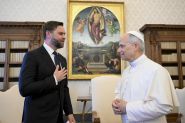- Home
- Middle East
- Hilarius or Simplicius, the Papal Name Dilemma

©SOLARO et Andreas SOLARO / AFP
From Pius to Clement, Hilarius to Simplicius, papal names through the centuries are inextricably linked to the brilliant or wretched legacies of the men who have ruled the Vatican.
Cardinals who will elect a new pontiff following the death of Pope Francis will already be mulling over the name they would choose if they were picked.
Very little time passes between their election, acceptance of the role, and appearance on a balcony high above St Peter's Square, where they announce their new title.
With so much weight placed on the significance of the papal moniker, they have to choose wisely.
The tradition of choosing a new name dates back to the sixth century, when an ordinary priest -- Mercurius -- was elected but felt he could not keep his pagan name. He swapped it for John, arguing that if Christ had renamed Simon, the first pope, as Peter, other popes could do the same.
Since then only one, Adrian VI in the 16th century, has kept his baptism name.
In 2013, Argentine Jorge Bergoglio became the first pope to take the name Francis after Saint Francis of Assisi, a 13th-century mystic who renounced his wealth and devoted his life to the poor.
Bookmakers had been betting he would call himself Leo -- which means lion.
While some names are associated with peace or theological brilliance, others have more controversial connotations.
There has not been a pope called Celestine since the name was taken in 1294 by a hermit, who was elected against his wishes and resigned from the post after five months. He was immortalised by the Italian poet Dante, who placed him in Hell for his "great refusal".
Francis's predecessor Benedict XVI also stepped down, so plumping for Benedict XVII or Celestine VI might spark speculation that an eventual resignation could be likely.
Orgies, necromancy
While popes in the first few centuries were called anything from Zachary to Adeodatus or Victor, from the 16th century onwards the same names have been circulating -- Clement, Gregory, Pius, Paul, Benedict -- and it is likely to be one of those, or a composite name.
John Paul I was the first in 1978 to bring two papal names together, to honour those who led the Roman Catholic Church during the Second Vatican Council, and John Paul II upheld the tribute when his predecessor died after just 33 days.
Those aspiring to emulate Francis's charismatic leadership might call themselves John Paul III -- or even just John, after "Good Pope John" XXIII, who called the Second Vatican Council and declared it his mission to open up the Church to the world.
While the name Pius might appear at first to have the right connotations, the last pope to go by it, Pius XII, was nicknamed "Hitler's Pope" by his detractors because of what they said was his silence during the Holocaust in World War II.
Gregory and Alexander also have unfortunate associations: Gregory VII, elected in 1073, was accused of necromancy and using a bed of nails to torture those who crossed him.
Alexander VI, a member of the wealthy Borgia family, was renowned for throwing wild orgies inside the papal palace.
One of the most bizarre popes of all time was ninth-century Stephen VII, who despised his predecessor Formosus so much that he had his rotting body dug up, dressed in papal robes and put on trial for occupying the papacy illegally.
Formosus was found guilty, the fingers he used to give blessings were chopped off and his body tossed in the Tiber -- an ungracious end which makes it unlikely that anyone will choose the name Formosus II, regardless of whether or not the trial was fair.
It would be a brave man who names himself Peter II.
The name is considered off limits out of respect for the Church's first pope and, according to a prophecy attributed to a 12th-century saint, the next Peter's pontificate will bring the destruction of Rome and kick off the Apocalypse.
By Ella Ide/AFP
Read more




Comments